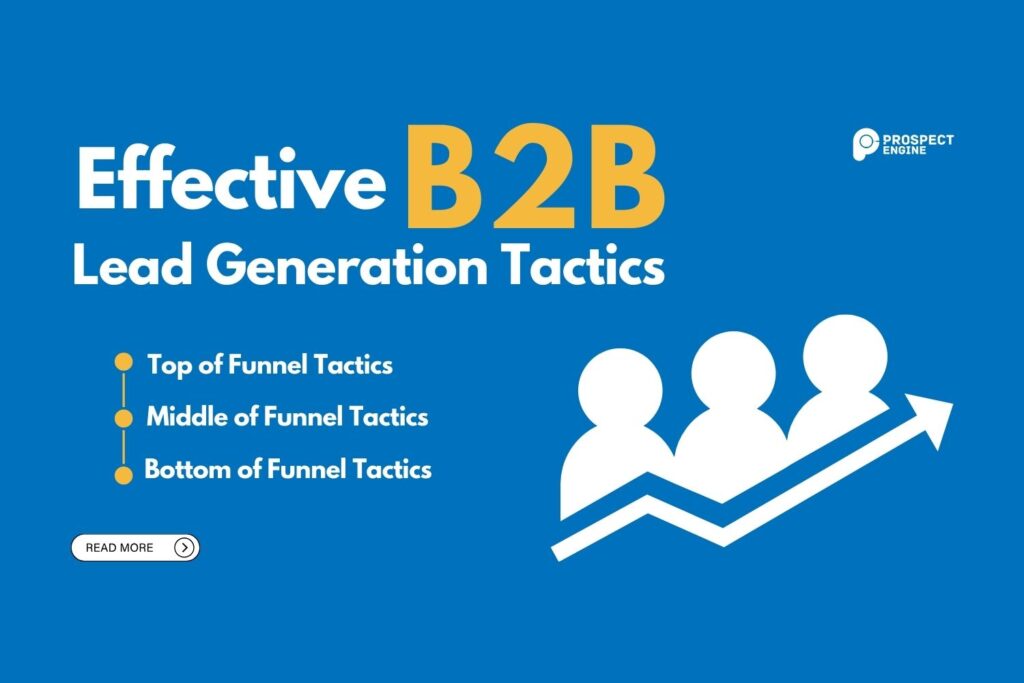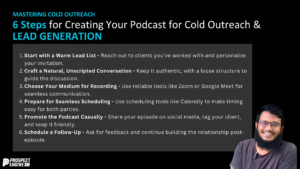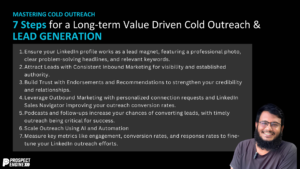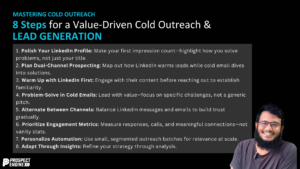Generating leads is absolutely crucial for the triumph of any B2B Company. Without a steady flow of quality sales leads, revenue goals can never be met. However, the B2B sales process cycle is longer and more complex than B2C. It requires meticulously crafted strategies to attract, engage, and nurture prospects until they become sales-ready leads. This is where the effective B2B lead generation tactics comes in.
This comprehensive guide will explore the foundations of effective B2B lead generation strategies and provide actionable tactics you can implement right away.
Table of Contents
Why B2B Lead Generation Matters
In B2B, building awareness and consideration takes much more effort compared to consumer purchases. The average sales cycle length is 3-6 months and involves many stakeholders.
According to Forrester, B2B buyers are 57% through the purchase process before they even consider contacting a vendor. That’s why inbound lead generation is crucial for sales success.
With more qualified prospects to work, sales and marketing teams can spend less time cold calling. Better leads make boosting pipeline and achieving revenue growth targets much easier.
Investing in the right lead gen strategies provides a positive ROI long-term. The more quality leads marketing produces, the more sales can close and scale revenue.
Understanding the B2B Lead Generation Landscape
Successful lead generation starts with understanding two key concepts – the buyer’s journey and the role of valuable content. Align your strategies with how B2B prospects research and buy.
The B2B Buyer’s Journey
Unlike impulse purchases, B2B buyers follow a lengthy, complex journey before deciding on a vendor. There are usually multiple decision makers each with their own selection criteria.
According to DemandGen, the B2B buyer’s journey comprises of 5 key stages:
Problem Awareness: The buyer acknowledges the need to address a business problem and is unsatisfied with the current situation.
Information Gathering: Extensive online research about the problem and solutions. Content consumption.
Vendor Selection: A shortlist of vendors is created based on product fit, reviews, thought leadership etc.
Solution Validation: Discussions with shortlisted vendors via demos, trials, PoCs. Detailed product evaluations.
Selection: Final vendor choice is made based on ability to meet needs, ROI, and long term value.
Lead generation tactics focus on identifying prospects in the early stages and nurturing them towards becoming sales qualified leads.
The Role of Content in B2B Lead Generation
Content marketing strategy provides the fuel for every B2B lead generation campaign. Quality content is needed to attract prospects, convert them into leads, and continue nurturing.
At every stage of the buyer’s journey, prospects are searching for and consuming different types of content:
Awareness stage: Blog posts, ebooks, whitepapers, case studies
Information Gathering: Comparison guides, product reviews, analyst reports, webcasts
Selection: Product docs, demo videos, free trials, proofs of concept
Without inbound marketing content, companies become invisible to prospects searching for solutions online. Content brings in traffic, establishes authority, and builds trust with buyers.
According to DemandGen Report, 91% of B2B buyers find content created by vendors valuable in decision making. Content also generates over 3 times more leads than traditional campaigns.
Effective B2B Lead Generation Tactics
Now let’s explore proven and effective B2B lead generation tactics for each stage of the sales funnel – from driving awareness to generating sales-ready leads.
Top of Funnel Tactics
These tactics focus on attracting completely new prospects into your funnel by increasing brand awareness and interest.
Blogging
Blogging is the most powerful inbound lead generation tactic. Did you know that businesses that maintain a blog attract 55% more visitors to their website? They also generate 67% more leads than non-blogging firms according to HubSpot.
Industry and thought leadership blog content like tips, how-tos and case studies establish authority. SEO optimized blogging improves search engines visibility so prospects find you when researching problems.
To boost the visibility of your blog posts and attract a broader target audience, it’s advisable to share them on social media. Repurpose blogs into visual quotes for Instagram and LinkedIn.
Encourage subscribers and share with CTAs like “Spread the word” and “Share with a friend”. Enable commenting to facilitate discussions.
Social Media Engagement
One effective way to increase the visibility of your blog posts and other content is by sharing them on social media. It increases its visibility to more of your target audience. Participate in relevant social conversations using popular hashtags.
LinkedIn and Twitter are best for B2B marketers. Share content and engage on your B2B Company Page, LinkedIn Groups, re-share others’ content. Leverage employee networks.
Industry Forums & Communities
Actively participate in leading industry forums and communities like Quora and Reddit related to your niche. Provide value by answering people’s questions.
Link to helpful resources – your content, other tools. This shows your expertise. Ensure you disclose affiliation with your brand.
Paid Advertising
Paid social platform ads and Google Ads target prospects actively searching for solutions using relevant keywords. Retargeting warm leads to cold traffic.
Focus ads on high-intent keywords like “[solution] pricing” and “[problem] alternatives”. Continually optimize based on cost per lead.
SEO
SEO improves organic search visibility and traffic to your site. Optimize pages and content for keywords prospects use during research.
On-page SEO includes meta tags, URLs, page speed. Build links via guest posting on authority websites to improve domain authority.
Middle of Funnel Tactics
These tactics nurture prospects that have shown initial interest in MQLs and SQLs.
Content Offers/Lead Magnets
Offer premium gated content like ebooks, templates, and whitepapers in exchange for prospect contact info. Offer relevant, valuable resources tailored to their needs.
Promote your offers everywhere – website banners, blog posts, social media accounts, email campaigns. Lead magnet examples: industry reports, comparison guides, ROI calculators.
Webinars/Webcasts
Webinars showcase thought leadership while interacting directly with prospects. Promote webinars across the marketing channels – email, social media, paid ads.
Offer the webinar recording as gated content to capture leads. Sprinkle in case studies and client testimonials to build credibility.
Email Nurturing
Email marketing is still an indispensable lead nurturing tactic. Make an email list and send targeted, personalized content based on prospect interests and actions.
Nurture cold prospects with helpful resources to warm them up. Put leads that previously engaged but went cold back into automated nurturing streams.
Retargeting Ads
Retarget visitors who previously engaged with your brand via ads across websites they browse. Send targeted offers based on content consumed. So that they can turn visitors into leads.
For example, if they downloaded a product guide, retarget with a demo offer. Continual exposure builds familiarity.
Direct Mail
While not as scalable as digital tactics, a well-crafted direct mail campaign delivers results. Send high-quality print booklets showcasing customer success stories.
Include a call to action to visit your site or contact sales. Direct mail campaigns have higher recall compared to digital.
Bottom of Funnel Tactics
These tactics convert marketing qualified leads into sales qualified and closeable opportunities.
Lead Scoring
Lead scoring models rate MQLs based on engagement, profile, and behavior data to identify sales-ready prospects. Route hot leads to reps faster.
Score leads based on activity like emails opened, gated content downloads, site page visits. Verified contact info also boosts score.
Sales-Ready Content
Convert late-funnel leads into opportunities by providing content that helps guide final selection – analyst reports, ROI calculators, TCO worksheets.
Live demos and free trials remove remaining barriers. Case studies and testimonials address concerns. FAQs answer common questions.
Calls-to-Action (CTAs)
Compelling, urgent CTAs motivate visitors to convert across all channels – website, email, ads. Try CTAs like “Start Your Free Trial”, “See a Demo”, “Get Started Now”.
Multi-channel marketing and retargeting reinforces your brand’s messaging and CTAs. Be consistent.
Event Marketing
Events like webinars, tradeshows and conferences allow you to directly interact with many prospects live or digitally.
Booths, speaking sessions, sponsorships, etc. raise awareness. Capture lead details for giveaways and future nurturing. Follow up promptly.
Account-Based Marketing
An account-based approach tailors marketing to target key accounts that fit your ideal potential customer profile. Coordinate campaigns across channels to influence multiple potential buyers.
ABM initiatives convert accounts better by making key executives and decision makers feel valued. Take a strategic, personalized approach.
Leveraging Technology for B2B Lead Generation Strategies
Marketing technology provides automation and analytics to improve the effectiveness of lead gen programs.
Marketing Automation
Platforms like HubSpot and Marketo track prospect engagement across channels and deliver automated, tailored experiences.
Lead scoring, email address nurturing, landing pages, attribution reporting, alerts – MA powers hyper-personalization that converts.
CRM
A CRM like Salesforce manages the sales process from lead to potential customer journey in one place. Centralized prospect/customer data gives sales productivity and insights.
Well-integrated marketing automation and CRM systems create a seamless workflow from lead to revenue.
Landing Page Builders
Tools like LeadPages, Unbounce and Instapage help create optimized, high-converting landing pages for lead capture offers.
Drag and drop editing, A/B testing capabilities, lead capture forms, integrates with CRM/email marketing platforms.
Surveys
Online survey tools like SurveyMonkey provide an easy way to get feedback from prospects about needs, pain points, challenges.
Offer the survey results as a gated asset. Convert respondents into high-quality leads for further nurturing.
SEO and Analytics
SEO tools like SEMrush, Ahrefs and Moz provide keyword research, backlink analysis, rank tracking and site audits to improve organic visibility.
Analytics like Google Analytics helps you measure site organic traffic, lead source effectiveness, conversion paths to optimize efforts.
Measuring the Success of Lead Generation
Define metrics and continuously track results to refine strategies and boost ROI.
Key Performance Indicators
Measure marketing qualified lead volume, cost per lead, sales reps velocity, win rate, deal size metrics regularly. Benchmark against past performance and goals.
Revenue attribution modeling tracks leads through the funnel to determine the ROI of each program. Prioritize high-ROI initiatives.
Conversion Rate Optimization
CRO tools and split testing optimize landing pages, CTAs, email subject lines and other elements to improve conversions.
Review funnel drop off and identify leakages. Test page layouts, copy, visuals, offers, placement to increase lead sign-ups.
Surveys
Ask marketing generated leads that turned into prospective customers what content and campaigns influenced their decision.
Survey sales teams on quality of leads. Provide feedback to marketing on areas like lead qualification criteria, volume etc.
FAQ
Q: What are some top of funnel lead generation tactics?
A: Top of funnel tactics focus on driving new prospect awareness and interest. Examples include blogging, social media engagement, participating in industry forums & communities, SEM/SEO, and paid advertising.
Q: How can I nurture prospects and generate MQLs?
A: To nurture prospects into MQLs, use lead magnets, webinars, email nurturing, retargeting ads, and direct mail. Provide valuable content to prospects already showing interest.
Q: What tactics help convert MQLs into sales qualified leads?
A: Lead scoring, sales-ready content like demos and ROI calculators, compelling CTAs, account-based marketing, and events help turn MQLs into SQLs.
Q: What technologies can improve B2B lead generation?
A: Marketing automation, CRM, landing page builders, surveys, SEO tools, and analytics provide automation, insights, and optimization to boost lead gen performance.
Q: How do I measure the success and ROI of my lead gen campaigns?
A: Track KPIs like cost per lead, win rate, revenue per lead. Use conversion rate optimization and surveys to continually improve. Measure ROI of each channel and tactic.
Conclusion
Generating a predictable stream of qualified leads is essential to achieving B2B revenue growth targets. However, the complex and lengthy buying journey requires in-depth buyer persona research coupled with well-orchestrated, multi-channel tactics.
This guide provided a comprehensive overview of proven lead generation strategies across the funnel – from driving awareness to delivering sales-ready opportunities.
To summarize, focus on creating relevant, valuable content for each buying stage. Combine inbound and outbound tactics like SEO, social media, events, email, paid ads, direct mail and more. Leverage marketing automation and CRM to deliver personalized, timely experiences.
Most importantly, continually measure results through lead volume, cost per lead, conversion rates, win rates, and sales cycle length. Use actionable insights to refine your lead generation engine.





